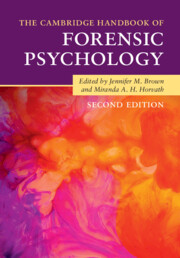Book contents
- The Cambridge Handbook of Forensic Psychology
- The Cambridge Handbook of Forensic Psychology
- Copyright page
- Dedication
- Contents
- Figures
- Tables
- Contributors
- Preface
- Forensic Psychology
- Part I Psychological Underpinnings
- 1.1 Cognitive Theories of Crime
- 1.2 Child and Adolescent Offending
- 1.3 Investigative Psychology
- 1.4 Neurological Theories
- 1.5 Personality
- 1.6 Theories of Sexual Offending
- 1.7 The Psychology of Violent Behavior
- 1.8 Investigative Decision-Making
- Part II Psychology and Criminal Behaviour
- Part III Assessment
- Part IV Interventions
- Part V Civil Proceedings
- Part VI Professional Practices
- Index
- References
1.8 - Investigative Decision-Making
from Part I - Psychological Underpinnings
Published online by Cambridge University Press: 02 December 2021
- The Cambridge Handbook of Forensic Psychology
- The Cambridge Handbook of Forensic Psychology
- Copyright page
- Dedication
- Contents
- Figures
- Tables
- Contributors
- Preface
- Forensic Psychology
- Part I Psychological Underpinnings
- 1.1 Cognitive Theories of Crime
- 1.2 Child and Adolescent Offending
- 1.3 Investigative Psychology
- 1.4 Neurological Theories
- 1.5 Personality
- 1.6 Theories of Sexual Offending
- 1.7 The Psychology of Violent Behavior
- 1.8 Investigative Decision-Making
- Part II Psychology and Criminal Behaviour
- Part III Assessment
- Part IV Interventions
- Part V Civil Proceedings
- Part VI Professional Practices
- Index
- References
Summary
A detailed account of the history and current developments in the field of investigative decision making. This covers broad decision making theory, namely: traditional decision theory, heuristic and biases, fast and frugal heuristics and naturalistic decision making. This is applied to the current challenges faced by the police with research examples used to illustrate their relevance. The phenomenon of indecision is also discussed in the context of investigations, with consideration to why this occurs as well as considering the devasting and far reaching consequences this can have to an investigation.
Keywords
- Type
- Chapter
- Information
- The Cambridge Handbook of Forensic Psychology , pp. 154 - 164Publisher: Cambridge University PressPrint publication year: 2021



